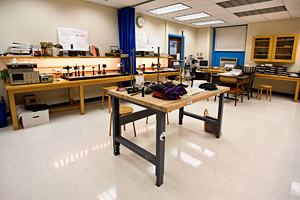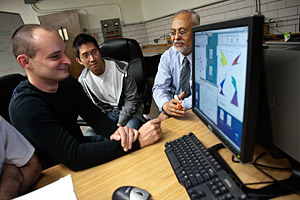Facilities
State-of-the-Art Facilities Lead to Groundbreaking Discoveries
As a student in the Physics Department at WPI you’ll have access to modern research facilities in which you will collaborate with world-class faculty members while exploring matter and energy, and the interaction between them.
Working with sophisticated instruments in these facilities, you’ll be exposed to meaningful work, and you’ll be challenged to make your own discoveries, guided by some of the top researchers and theorists in this ever-changing field.
Learn about a few of our pioneering physics laboratories:
IPG Photonics Laboratory

Photonics, the study and application of light, can be used to describe older technology (such as light bulbs) and newer discoveries, such as fiber optic communication. Photonics impact such diverse industries as telecommunications, consumer electronics, and medicine.
The IPG Photonics Laboratory is used to teach photonics with emphasis on fibers, lasers, and detectors. The lab is used for classes, research, student projects, and tours for prospective students. Current experiments being conducted are classified into four categories: fiber optics, detectors, lasers, and optics.
Available equipment in the lab:
- fiber communication set-up
- EDFA
- diode laser testing equipment
- diode laser drivers (500mA, DC-150kHz modulated)
- interferometers
- optical spectrum analyzer (600-1700nm, 20pm resolution)
- CCD camera (400-900nm)
- digital storage oscilloscope (500MHz bandwidth, waveform averaging),
- He-Ne lasers (red & green, 0.5mW), diode lasers (670nm and 785nm, 5mW)
- Si and InGaAs photodetectors (10MHz), Si photodiode array
- fiber optic components
The User-Friendly Characterization Laboratory
The User-Friendly Characterization Laboratory (UFC-Lab) was created for undergraduate research and other projects needing basic characterization.
- Optical microscope, 3.5-180X in stereo, X-Y stage, 10 MP digital camera;
- Scanning electron microscope, 120-10,000X, auto/manual focus and contrast & brightness;
- Atomic force microscope, scans up to 70 x 70 μm2 areas with maximum height change of 14 μm;
- Fourier-transform infrared spectrometer, 350-8,000 cm-1, spectral resolution better than 2cm-1;
- X-ray fluorescence spectrometer, PPM to 100 % elemental composition from Mg to U.
The UFC-Lab is located in Olin Hall 009. For general information, please go to the UFC-Lab website. To begin the process of becoming a user, please self-enroll at this canvas site. Express your interest in being trained on the tools by taking the Interest Survey. Please plan well in advance for training; training is conducted by busy faculty volunteers. After training, access to each tool (and the lab itself) requires passing a qualification quiz. Qualified users must follow tool, lab, and reservation protocols.
The Center for Computational Nanoscience (CCN)

The CCN was created to address nonlinear problems in many fields using a multidisciplinary approach. Ideas come from physics, numerical analysis, computer science, and other fields of research. Some areas of research being addressed at the CCN include quantum modeling of nanostructures, quantum computation, designing MEMS (micro-electromechanical systems), NEMS (nanoscale electromechanical systems), multi-component diffusion in fluids and solids, nonlinear optics, and mathematical biology.